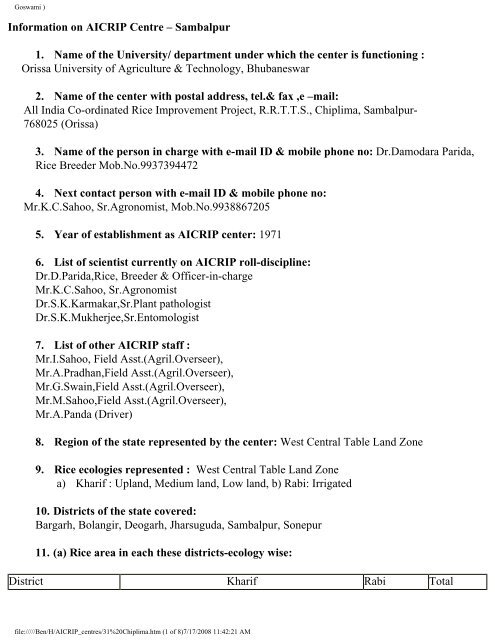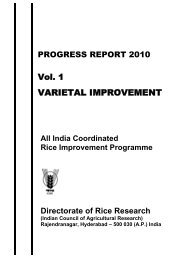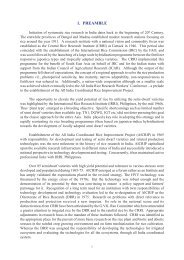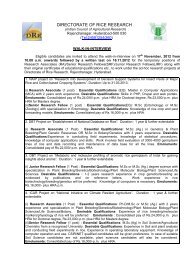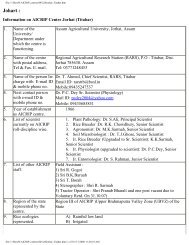31 Chiplima.pdf - Directorate of Rice Research
31 Chiplima.pdf - Directorate of Rice Research
31 Chiplima.pdf - Directorate of Rice Research
You also want an ePaper? Increase the reach of your titles
YUMPU automatically turns print PDFs into web optimized ePapers that Google loves.
Goswami )<br />
Information on AICRIP Centre – Sambalpur<br />
1. Name <strong>of</strong> the University/ department under which the center is functioning :<br />
Orissa University <strong>of</strong> Agriculture & Technology, Bhubaneswar<br />
2. Name <strong>of</strong> the center with postal address, tel.& fax ,e –mail:<br />
All India Co-ordinated <strong>Rice</strong> Improvement Project, R.R.T.T.S., <strong>Chiplima</strong>, Sambalpur-<br />
768025 (Orissa)<br />
3. Name <strong>of</strong> the person in charge with e-mail ID & mobile phone no: Dr.Damodara Parida,<br />
<strong>Rice</strong> Breeder Mob.No.9937394472<br />
4. Next contact person with e-mail ID & mobile phone no:<br />
Mr.K.C.Sahoo, Sr.Agronomist, Mob.No.9938867205<br />
5. Year <strong>of</strong> establishment as AICRIP center: 1971<br />
6. List <strong>of</strong> scientist currently on AICRIP roll-discipline:<br />
Dr.D.Parida,<strong>Rice</strong>, Breeder & Officer-in-charge<br />
Mr.K.C.Sahoo, Sr.Agronomist<br />
Dr.S.K.Karmakar,Sr.Plant pathologist<br />
Dr.S.K.Mukherjee,Sr.Entomologist<br />
7. List <strong>of</strong> other AICRIP staff :<br />
Mr.I.Sahoo, Field Asst.(Agril.Overseer),<br />
Mr.A.Pradhan,Field Asst.(Agril.Overseer),<br />
Mr.G.Swain,Field Asst.(Agril.Overseer),<br />
Mr.M.Sahoo,Field Asst.(Agril.Overseer),<br />
Mr.A.Panda (Driver)<br />
8. Region <strong>of</strong> the state represented by the center: West Central Table Land Zone<br />
9. <strong>Rice</strong> ecologies represented : West Central Table Land Zone<br />
a) Kharif : Upland, Medium land, Low land, b) Rabi: Irrigated<br />
10. Districts <strong>of</strong> the state covered:<br />
Bargarh, Bolangir, Deogarh, Jharsuguda, Sambalpur, Sonepur<br />
11. (a) <strong>Rice</strong> area in each these districts-ecology wise:<br />
District Kharif Rabi Total<br />
file://///Ben/H/AICRIP_centres/<strong>31</strong>%20<strong>Chiplima</strong>.htm (1 <strong>of</strong> 8)7/17/2008 11:42:21 AM
Goswami )<br />
Upland Medium<br />
land<br />
Lowland Total<br />
Bolangir 73 63 84 220.39 4.20 224.59<br />
Bargarh 36 132 80 247.70 64.96 <strong>31</strong>2.66<br />
Deogarh 14 22 12 48.55 1.55 50.10<br />
Jharsuguda 17 26 13 56.30 0.65 56.95<br />
Sambalpur 19 84 36 138.57 6.51 145.08<br />
Sonepur 15 44 39 97.70 19.67 117.37<br />
11.(b) Season wise & District wise irrigated <strong>Rice</strong> area in West Central Table Land Zone <strong>of</strong> Orissa<br />
(000’Hectares)<br />
District Kharif Rabi Total<br />
Bolangir 13.74 4.20 17.94<br />
Bargarh 111.67 64.96 176.63<br />
Deogarh 14.23 1.55 15.78<br />
Jharsuguda 7.57 0.65 8.22<br />
Sambalpur 51.20 6.51 57.71<br />
Sonepur 52.19 19.67 71.86<br />
12. Normal rainfall:<br />
Month Rainfall(mm) No.<strong>of</strong> Rainy days<br />
January 15.8 2<br />
February 20.9 3<br />
March 15.0 4<br />
April 14.7 3<br />
May 33.7 5<br />
June 230.5 14<br />
July 387.5 21<br />
August 419.9 20<br />
September 215.1 14<br />
October 48.2 4<br />
November 16.0 1<br />
December 10.9 1<br />
Total 1428.2 92<br />
13. Soil type and fertility status:<br />
file://///Ben/H/AICRIP_centres/<strong>31</strong>%20<strong>Chiplima</strong>.htm (2 <strong>of</strong> 8)7/17/2008 11:42:21 AM
Goswami )<br />
Agro-ecological situation Soil-type<br />
Table land canal irrigated Mixed red & yellow<br />
Table land rain-fed Mixed red & yellow, black<br />
Plain land-canal irrigated Laterite & Lateritic<br />
Plain land-rain-fed Red<br />
Undulating plain drought prone Mixed red & Black<br />
Undulating sub-mountainous tract rain-fed Mixed red & yellow<br />
Plateau-rain-fed Lateritic, Laterite mixed red & yellow<br />
14. Popular rice varieties: Kharif<br />
(i) Up-land : Khandagiri, Udayagiri, Bandana, Siddhanta<br />
(ii) Medium Land : Konark, Surendra, Swarna, Lalat, MTU 1001, Pratikshya<br />
(iii) Lowland : Mahanadi, CR 1009, CR 1014, Indrabati<br />
15. Major production constrains:<br />
(i) Biophysical Constraints:<br />
* Erratic distribution <strong>of</strong> monsoon rains lead to moisture stress at critical stages. Initial/<br />
terminal droughts have become very frequent for rain-fed upland rice.<br />
* Severe weed competition in rain-fed rice.<br />
* Soil acidity and poor moisture holding capacity <strong>of</strong> soils in rain-fed eco-system.<br />
* Areas in the tail end <strong>of</strong> canals are deprived <strong>of</strong> adequate quantity <strong>of</strong> water in time<br />
* Whereas water logging problem is observed in upper end <strong>of</strong> the canal due to poor<br />
drainage<br />
* In canal irrigated areas soil health has degraded owing to continuous rice cropping,<br />
mismanagement <strong>of</strong> irrigation and imbalance fertilizer use.<br />
* Formation <strong>of</strong> plough pan in sub soil and deformation <strong>of</strong> soil structure have taken place.<br />
* Toxicities <strong>of</strong> Fe and A1, deficiency <strong>of</strong> secondary and micronutrients are also coming up.<br />
* Pests (Gall Midge, Stem borer, BPH, WBPH, Case worm, Leaf folder, etc.) and diseases<br />
(Blast, BLB, Sheath rot, Sheath blight, Neck blast, etc.) have become endemic.<br />
(ii) Institutional Constraints:<br />
● Unavailability <strong>of</strong> quality seeds <strong>of</strong> desired varieties in sufficient quantity<br />
● Want <strong>of</strong> proper coordination among different departments like irrigation, electricity, financial<br />
institutions, agricultural extension and research.<br />
● Obtaining prescription for remedial measures against soil and crop related problems is not<br />
within easy reach <strong>of</strong> farmers.<br />
● Distress sale <strong>of</strong> produce resulting in non payment <strong>of</strong> loans.<br />
file://///Ben/H/AICRIP_centres/<strong>31</strong>%20<strong>Chiplima</strong>.htm (3 <strong>of</strong> 8)7/17/2008 11:42:21 AM
Goswami )<br />
(iii) Socio economic constraints:<br />
● Fragmented land holding and smaller holding size.<br />
● Unavailability <strong>of</strong> work force i.e. agricultural labourers delays agricultural operations<br />
● Tenant farming system has led to improper soil care in irrigated areas.<br />
● In canal-irrigated tract, major agricultural operations are carried out on contract basis. Contract<br />
labourers are in the process <strong>of</strong> dictating terms with land owners and do not agree to adopt some<br />
<strong>of</strong> the recommended package <strong>of</strong> practices like shallow erect planting, maintenance <strong>of</strong> desired<br />
plant population, proper manual weeding etc.<br />
16. Major contribution <strong>of</strong> the centre in terms <strong>of</strong> varieties/technologies developed:<br />
16.1 Crop Improvement (Plant Breeding)<br />
16.1.1 <strong>Rice</strong> varieties developed at <strong>Chiplima</strong>:<br />
The high yielding rice varieties Lalat and Meher developed at AICRIP, <strong>Chiplima</strong> are widely<br />
grown in Orissa in both Kharif and Rabi seasons. Lalat covers more than 60 percent <strong>of</strong> rice area <strong>of</strong><br />
Orissa in Rabi season. Recently two rice cultures have been released in the State <strong>of</strong> Orissa in the name<br />
<strong>of</strong> Pratikshya & Siddhanta.<br />
Variety Parentage Duration<br />
(days)<br />
Grain type Resistance to pests<br />
& diseases.<br />
Lalat 0BS677/IR36//Vikram/W1263 125-135 M.S. GM,BPH,WBPH<br />
BL, BLB<br />
Meher OBS677/IR36//Vikram/W1263 130-140 L.B. GM,BPH,WBPH,<br />
BL, BLB,RTV<br />
Pratikshya Swarna/IR-64 135-140 MS GM 1 & 4<br />
Siddhanta Jajati/Annapurna 105 SB BPH,GM-5<br />
16.1.2 Promising <strong>Rice</strong> Cultures Developed at <strong>Chiplima</strong><br />
The rice culture ORS 232-6 has been identified by DRR, Hyderabad through co-ordinated trials<br />
for release in Orissa. Proposal will be submitted very soon to the S.V.R.C. for their release in Orissa.<br />
Designation Parentage Duration(days) Grain Type Resistance to pests<br />
& diseases<br />
ORS 232-6 Shrabani/IET-9904 135 MS R:GM,MR:Sh.B<br />
16.1.3 Identification <strong>of</strong> suitable rice varieties for different ecosystems<br />
The high yielding varieites recently released by O.U.A.T. after evaluation at AICRIP, <strong>Chiplima</strong><br />
are gaining popularity by the farming community <strong>of</strong> Orissa.<br />
Upland Khandagiri, Udayagiri<br />
Medium Land Bhoi, Gajapati, Konark, Surendra,<br />
Kharabela and Sebati<br />
Lowland Mahanadi, Indravati, Prachi and Ramchandi<br />
file://///Ben/H/AICRIP_centres/<strong>31</strong>%20<strong>Chiplima</strong>.htm (4 <strong>of</strong> 8)7/17/2008 11:42:21 AM
Goswami )<br />
16.2 Crop Production(Agronomy)<br />
16.2.1 Effective herbicides for transplanted rice:<br />
Application <strong>of</strong> Butachlor 50EC @ 1.0kg a.i./ha (800ml/Acre) or Butachlor 50EC + 2, 4-D EE 32 EC<br />
@ (1.0+0.4) kg a.i/ha (800ml + 500ml/Acre) or Butachlor + Almix (750 ml + 20gms/Acre) are<br />
effective herbicides.<br />
16.2.2. Effective herbicides for upland condition:<br />
Application <strong>of</strong> Pendimethalin 30EC @ 1kg a.i./ha at 7 days after rice emergence (DARE) followed by<br />
2, 4-D Na salt 80 WP @0.6 kg a.i./ha at 25 DARE was found effective for controlling weeds in upland<br />
rice.<br />
16.2.3 Effective herbicide for direct sown puddled rice:<br />
Mixture <strong>of</strong> Butachlor + Safener @ 1.5kg a.i./ha at 3 DAS is themost effective in controlling the weeds<br />
with higher yield.<br />
16.2.4 Intercropping in rice under rainfed upland condition:<br />
Out <strong>of</strong> three <strong>Rice</strong> – Groundnut combinations (2:1, 3:1 and 4:1), intercropping <strong>of</strong> rice with groundnut<br />
(Var OG 52-1) in 2:1 ratio was maximum pr<strong>of</strong>itable than the sowing <strong>of</strong> sole rice (Var Parijat). Sole<br />
crop <strong>of</strong> groundnut (OG 52-1) followed by rice-groundnut (2:1) was superior in land equivement ration<br />
(LER) and net return.<br />
16.2.5 Use <strong>of</strong> 8 row drum seeder in direct seeded puddled condition:<br />
● Sowing <strong>of</strong> sprouted seeds <strong>of</strong> rice by using 8-row drum seeder just one day after puddling.<br />
● Use <strong>of</strong> herbicide “Butachlor” at 4-6 days after sowing.<br />
● One hand weeding at maximum tillering stage is the best package <strong>of</strong> practices for direct seeding<br />
with higher yield (4.7t./ha)<br />
16.2.6 Cultural management practice for higher grain yield <strong>of</strong> rainfed upland rice :<br />
Application <strong>of</strong> NPK @ 40:20:20kg.ha (50% <strong>of</strong> the recommended dose) along with F.Y.M. @ 5<br />
ton/ha recorded maximum grain yield (2.6.t./ha).<br />
16.2.7 Package <strong>of</strong> practices for hybrid rice :<br />
The following package <strong>of</strong> practices is recommended for the zone to get higher yield from hybrid rice<br />
varieties DRRH – 1, PA-6201, PHB-71 and PAC-8<strong>31</strong>.<br />
* Seed density @ 10-20 gms/m2 <strong>of</strong> nursery.<br />
* Use <strong>of</strong> 2 seedings / hill<br />
* Timely planting with 120:60:40 kg NPK/ha + 25kg ZnSO4/ha<br />
* Application <strong>of</strong> 50% <strong>of</strong> N as basal, 25% N at tillering and 20% N at booting stage as<br />
prilled urea.<br />
16.3 Crop Protection (Entomology)<br />
16.3.1 Effective Granular & Sprayable insecticides for control <strong>of</strong> rice pests<br />
Insecticides (Granular) Dose<br />
(kg a.i/ha)<br />
Insect pests<br />
Fipronil (Regent 0.3G) 0.075 Stem borer, Gall midge, BPH and WBPH<br />
file://///Ben/H/AICRIP_centres/<strong>31</strong>%20<strong>Chiplima</strong>.htm (5 <strong>of</strong> 8)7/17/2008 11:42:21 AM
Goswami )<br />
Isazophos (Miral 3G) 1.000 Stem borer, Gall midge, BPH and WBPH<br />
Carbosulfan (Marshall 6G) 1.000 Stem borer, Gall midge,<br />
Chlorpyriphos (Coroban 10G) 1.000 Gall midge, Stem borer<br />
Carb<strong>of</strong>uran (Furadan 3G) 1.000 Stem borer, Gall midge, BPH, WBPH<br />
Insecticides (Sprayable) Dose Insect pests<br />
(kg a.i/ha)<br />
Chlorpyriphos (Dursban 20EC, 0.400 Stem borer, Gall midge, BPH, WBPH and<br />
Coroban 20EC)<br />
Leaf folder<br />
Monocrotophos (Nuvacron 36SC) 0.400 -do-<br />
Cartap hydrochloride (Caldan 50SP) 0.250 Leaf folder<br />
Imidacloprid (Confidor 200 SL) 0.025 BPH & WBPH<br />
Ethiprole (Ethiprole 10 SC) 0.050 BPH & WBPH<br />
Thiacloprid (Calypso 240 SC) 0.120 BPH & WBPH<br />
Eth<strong>of</strong>enprox (Trebon 10 EC) 0.050 BPH & WBPH<br />
Carbaryl (Sevin 50 WP) 0.250 BPH & WBPH<br />
Phosphamidon (Dimecron 5EC) 0.400 Stem borer<br />
Quinalphos (Ekalux 25 EC) 0.400 Stem borer<br />
Bupr<strong>of</strong>ezin (Applaud 25SC) 0.200 Stem borer<br />
Silaflu<strong>of</strong>en (Silaflu<strong>of</strong>en 20 EC) 0.100 Stem borer<br />
Thiomethoxam (Actara 25 WG) 0.025 Stem borer<br />
16.3.2 Nursery and Early Stage Pest Control in <strong>Rice</strong> :<br />
Application <strong>of</strong> Fipronil (Regent 0.3G) or Isazophos (Miral 3G) or Carb<strong>of</strong>uran (Furadan 3G) @<br />
1.0kg a.i./ha in nursery 5 days before uprooting the seedlings controlled the early stage pests like<br />
stem borer, gall midge and whorl maggot effectively on the transplanted crop in mainfield upto one<br />
month. It could be used as a better substitute over seedling root dip with chlorpyriphos.<br />
16.3.3 Use <strong>of</strong> commercial neem formulation and neem derivatives for rice pest<br />
management:<br />
● Commercial neem formulations like Rakshak liquid @ 0.5% or Neemazal liquid @ 0.3% or<br />
Achook solid @ 2% or Econeem liquid @ 0.5% was found effective against plant hoppers and<br />
leaf folders and safer to natural enemies like spiders and ladybird beetles.<br />
● Use <strong>of</strong> Neem oil 3% alone or in combination with monocrotophos (1.5% Neem oil + 0.05%<br />
Monocrotophos) or application <strong>of</strong> 5% Neem Seed Karnel Extract (NSKE) was found effective<br />
against leafhoppers, planthoppers and leaffolders <strong>of</strong> rice.<br />
16.3.4 Use <strong>of</strong> pheromone trap for IPM:<br />
Use <strong>of</strong> pheromone traps @ 8 traps / acre at a distance <strong>of</strong> 60 meters apart (one trap each 500sq.m.<br />
area) is recommended for the farming community for YSB management under IPM.<br />
16.3.5 Integrated Pest Management (IPM) :<br />
The following IPM module has been advocated for the West Central Table Land Zone <strong>of</strong> Orissa.<br />
* Use <strong>of</strong> a resistant variety like Lalat or Pratikshya<br />
file://///Ben/H/AICRIP_centres/<strong>31</strong>%20<strong>Chiplima</strong>.htm (6 <strong>of</strong> 8)7/17/2008 11:42:21 AM
Goswami )<br />
* Summer ploughing in May.<br />
* Early planting within 15th July during Kharif.<br />
* Nursery application <strong>of</strong> Carb<strong>of</strong>uran (Furadan 3G) @ kg a.i./ha 5 days before uprooting the<br />
seedling against early stage pests <strong>of</strong> transplanted rice in main field.<br />
* Use <strong>of</strong> pheromone traps @ 8 traps / Acre for mass trapping <strong>of</strong> YSB and<br />
* Need based application <strong>of</strong> Eth<strong>of</strong>enprox @ 500 ml/ha or Imidacloprid @ 125 ml/ha<br />
against plant hoppers.<br />
16.4 Crop Protection (Plant Pathology)<br />
16.4.1 Effective fungicides for disease management<br />
Dose/Acre Disease<br />
Fungicide<br />
Tricyclazole (Beam 75WP) 120gm Blast, Nect blast<br />
Propiconazole (Tilt 25 EC) 200ml Sheath blight, Sheath rot<br />
Hexaconazole (Contaf 50 EC) 200ml Sheath blight, Sheath rot<br />
Chlorthalonil (Chlorthalonil 75 W.P.) 200ml False Smut<br />
Chlorthalonil (Kavach 40 E.C.) 400 ml False Smut<br />
Plantomycin + Copper Oxychloride (200gms +<br />
400 gms)<br />
Bacterial leaf blight<br />
16.4.2 Effective Botanicals for controlling sheath rot, sheath blight, false smut <strong>of</strong> rice.<br />
Promising botanicals Dose/acre No. <strong>of</strong> sprays at 15 days interval<br />
Achook 50.g/litre 3 to 4<br />
Neem Azal 3.0ml/litre 3 to 4<br />
Neem gold 20.0 ml/litre 3 to 4<br />
16.4.3 Control <strong>of</strong> complex <strong>of</strong> rice diseases:<br />
Use <strong>of</strong> Plantomycin, Carbendazim and Copper Oxychloride mixture in proportion <strong>of</strong> 1:1:2.5g.<br />
per litre <strong>of</strong> water against complex disease syndrome <strong>of</strong> Blast, BLB and Sheath rot.<br />
16.4.4 Optimum sowing time for disease escape:<br />
The optimum showing <strong>of</strong> Kharif and Rabi are 1st fortnight <strong>of</strong> July and 1st fortnight <strong>of</strong> January<br />
respectively for escape <strong>of</strong> disease like Blast, BLB, Seath rot and Sheath blight.<br />
17.Any other relevent information:<br />
file://///Ben/H/AICRIP_centres/<strong>31</strong>%20<strong>Chiplima</strong>.htm (7 <strong>of</strong> 8)7/17/2008 11:42:21 AM
Goswami )<br />
file://///Ben/H/AICRIP_centres/<strong>31</strong>%20<strong>Chiplima</strong>.htm (8 <strong>of</strong> 8)7/17/2008 11:42:21 AM


